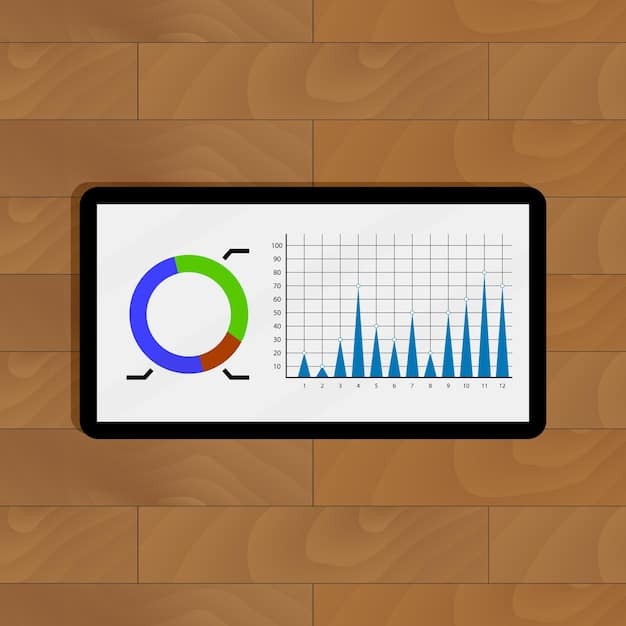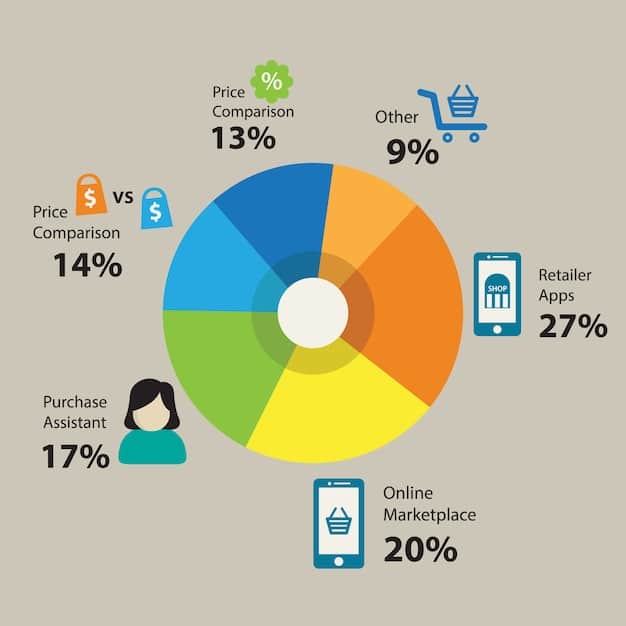Social Media ROI in 2025: Measuring Your Marketing Impact

Social Media ROI (Return on Investment) in 2025 requires advanced analytics and strategic alignment with overall business objectives to accurately measure the impact of social media efforts.
In the rapidly evolving landscape of social media, understanding and maximizing your Social Media ROI: Measuring the Impact of Your Social Media Efforts in 2025 is more critical than ever.
Understanding Social Media ROI in 2025
Social media has moved beyond just engagement metrics. In 2025, calculating the true social media ROI means understanding how social activities directly contribute to revenue, brand equity, and other key business outcomes.
Let’s explore what this entails and how you can adapt your strategies.
The Evolution of Social Media Metrics
Traditional metrics like likes and shares are becoming less relevant. Businesses need to focus on metrics that demonstrate a direct impact on the bottom line.
Focus on aligning your social media metrics with business goals to get a better understanding of overall success.
Key Performance Indicators (KPIs) to Watch
Identifying the right KPIs is crucial for measuring ROI effectively. Here are some KPIs that go beyond the basics:
- Customer Lifetime Value (CLV): Measuring how social media interactions contribute to the long-term value of a customer.
- Conversion Rates: Tracking the percentage of social media users who convert into leads or customers.
- Brand Sentiment Analysis: Monitoring how social media affects brand perception and reputation.
- Cost Per Acquisition (CPA): Determining the cost-effectiveness of acquiring customers through social media channels.
In conclusion, understanding social media ROI in 2025 requires a shift towards metrics that are aligned with business goals and reflect the true impact of social media efforts.
Advanced Analytics Tools for ROI Measurement
To accurately gauge social media ROI, marketers are leveraging an array of sophisticated analytics tools. These tools provide insights into customer behavior, channel performance, and the overall impact of social media campaigns.
Let’s dive into some of the most powerful technologies available.

AI-Powered Analytics Platforms
Artificial Intelligence (AI) is revolutionizing social media analytics by providing deeper insights and more accurate predictions. AI tools can analyze vast amounts of data to identify patterns, trends, and correlations that would be impossible to detect manually.
Platforms like Brandwatch and Talkwalker use AI to analyze sentiment, identify influencers, and track brand mentions in real-time.
Tracking Customer Journeys
Understanding the customer journey is crucial for determining the effectiveness of social media efforts. Today’s analytics tools allow marketers to track how customers interact with social media content at each stage of the buying process.
By mapping the customer journey, businesses can identify touchpoints that drive conversions and optimize their social media strategies accordingly.
In closing, advanced analytics tools are essential for measuring social media ROI in 2025, offering marketers the ability to make data-driven decisions and maximize the impact of their campaigns.
Strategies for Optimizing Social Media ROI
Optimizing social media ROI involves a multifaceted approach, combining data-driven insights with strategic content creation and audience engagement techniques.
Here are some key strategies to enhance the return on your social media investments.
Content Personalization
Personalized content resonates more effectively with audiences, driving higher engagement and conversion rates. Personalized content can be created based on demographics, interests, and past interactions.
Platforms like HubSpot and Marketo offer tools for creating personalized social media experiences, ensuring that your message is tailored to each individual’s needs.
Influencer Marketing
Collaborating with influencers can amplify your social reach and drive significant ROI. Influencer marketing is used to promote your brand to a large audience.
When choosing influencers, it’s important to look at their engagement rates and content quality.

Paid Social Media Advertising
Paid social media advertising offers precise targeting capabilities, allowing you to reach specific audiences with tailored messages. Paid social media advertising also allows you to use analytics to adjust your ads.
- Facebook Ads: Leverage Facebook’s detailed targeting options to reach specific demographics and interests.
- Instagram Ads: Use visually appealing content to capture attention and drive conversions.
- LinkedIn Ads: Target professionals with relevant job titles and industry affiliations.
- Twitter Ads: Engage in real-time conversations and promote trending topics to increase visibility.
In summary, optimizing social media ROI in 2025 requires a combination of personalized content, strategic influencer partnerships, and targeted paid advertising campaigns.
The Role of Video Content in Driving ROI
Video content has become a dominant force in social media, captivating audiences and driving higher engagement rates than static content. Incorporating video into your social media strategy can significantly boost your social media ROI.
Consider these tips for using video content when you determine ROI.
Live Video
Live video offers the chance to engage with your audience in real-time, fostering a sense of community and authenticity. Live streaming enhances engagement in ways that prerecorded materials don’t.
Platforms like Facebook Live, Instagram Live, and YouTube Live provide tools for hosting interactive video sessions.
Short-Form Video Content
Platforms like TikTok and Instagram Reels highlight the importance of short-form video in today’s social media landscape. These platforms are designed for short-form media, which is accessible to mobile users.
With their concise nature and engaging formats, short videos are perfect for capturing attention and driving quick conversions.
Video SEO
Optimizing video content for search engines can increase its visibility and drive organic traffic. By optimizing your videos, you can attract a significant audience.
Use relevant keywords in your video titles, descriptions, and tags to improve search rankings.
In conclusion, using video content will optimize your social media ROI in 2025, offering engagement, enhanced reach, and conversion opportunities.
Integrating Social Media with Other Marketing Channels
To maximize social media ROI, it’s essential to integrate social media efforts with other marketing channels. A cohesive, omni-channel approach ensures that your brand message is consistent and compelling across all touchpoints.
Here’s how you can integrate your strategy.
Email Marketing
Integrating social media with email marketing can enhance engagement and drive conversions. By coordinating the relationship, you can improve overall sales.
Use social media to grow your email list and promote email newsletters, while leveraging email to drive traffic to your social media profiles.
SEO (Search Engine Optimization)
Social media can indirectly influence SEO by driving traffic to your website and increasing brand visibility. Use SEO techniques to attract more organic views.
Share your website content on social media to drive traffic and improve search engine rankings. You can also use social media to build backlinks.
Content Marketing
Social media serves as a powerful distribution channel for content marketing efforts, amplifying reach and driving engagement. Use appealing content to attract engagement.
Share blog posts, articles, and other valuable content on social media to attract followers and establish thought leadership.
Effectively integrating with social media ROI in 2025 creates a holistic marketing strategy, ensuring consistent brand messaging.
Future Trends in Social Media ROI Measurement
As social media continues to evolve, so too will the methods and metrics used to measure social media ROI. Staying ahead of the curve and anticipating future trends is essential for maximizing the impact of your social media efforts.
Here are a few key trends to watch.
Augmented Reality (AR) and Virtual Reality (VR)
AR and VR technologies present new opportunities for creating immersive social media experiences that drive engagement and conversions. Keep an eye on your AR/VR experiences.
Brands are already experimenting with AR filters and VR experiences to promote products and services, and these trends are expected to accelerate in the coming years.
Blockchain Technology
Blockchain technology could transform social media by providing greater transparency and security. The technology is also used when transferring assets.
Blockchain-based social media platforms could offer new ways to reward content creators, verify user identities, and prevent fraud.
Voice Search Optimization
With the rise of voice assistants like Siri and Alexa, optimizing social media content for voice search will become increasingly important. Voice-based marketing can lead to high customer retention.
Use natural language and conversational keywords in your social media posts to improve visibility in voice search results.
Anticipating future trends helps to maximize your ROI in 2025, allowing adaptation to stay ahead of the curve.
| Key Point | Brief Description |
|---|---|
| 📈 ROI Metrics | Focus on CLV, conversion rates, and brand sentiment for accurate ROI. |
| 🤖 AI Analytics | Use AI tools for deeper insights and real-time monitoring of social data. |
| 🎯 Content Personalization | Personalize content based on demographics and engagement history. |
| 📱 Video Content | Incorporate live, short-form videos, and optimize with video SEO. |
[FAQ]
▼
Key metrics include Customer Lifetime Value (CLV), conversion rates, brand sentiment analysis, and Cost Per Acquisition (CPA). Focus on those metrics to have a better insight on your ROI.
▼
AI tools can analyze vast amounts of data to identify patterns, trends, and correlations. AI can also analyze sentiment, identify influencers, and track brand mentions in real-time.
▼
Video content enhances engagement and can drive higher conversion rates. Use live video, short-form content, and video SEO to increase visibility and attract traffic to your content.
▼
Yes, combining social media with other marketing efforts like email marketing, SEO and content marketing will maximize your ROI and result in a holistic marketing strategy, ensuring consistent brand messaging.
▼
AR/VR technologies, blockchain tools, and voice search, will offer new ways for brands to engage and measure content performance. By staying ahead of the curve, you will maximize the impact of your efforts.
Conclusion
Measuring and maximizing social media ROI in 2025 requires adapting to the latest technological advances and trends. Understanding metrics like CLV, and using AI-powered analytics tools is essential to measuring your ROAS. Social media will be crucial to marketing as we advance through the 21st century.





